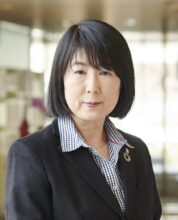Message from the President
Message from the President

My name is Hara Reiko , and I am the President of the Japan Society of Private Colleges and Universities of Nursing .
I would like to express my gratitude to all member schools for their constant support of our Society.
Founded in 1976 with 11 member schools, our Society now consists of 200 universities and 9 junior colleges, totaling 209 schools as of fiscal 2024. As private universities comprise 70% of all nursing universities, I believe that they bear a significant responsibility in nursing education and as such our Society plays a major role.
The purpose of this association is "to promote private nursing colleges and universities by conducting research and surveys on education, research, and management of private nursing colleges and universities, and by forming alliances and cooperating with other members, thereby contributing to the achievement of their missions and the progress and development of nursing and nursing science education and research in Japan.
In response to the "Grand Design for Higher Education Toward 2040," a report by the Central Council for Education, each of our member universities has been working on education with visible learning outcomes in order to realize the Grand Design based on the founding spirit of each university and its own educational philosophy.
In fiscal 2024, we will proceed with special projects inherited from the previous Board of Directors, namely, the Project to Promote Nursing Education in a Post-COVID Society , and the Project to Showcase the Appeal of Nursing .
The Project to Promote Nursing Education in a Post-COVID Society is a special subsidy program that aims to sustainably improve the quality of nursing education for the new era. During the COVID-19 pandemic, member schools made use of ICT in nursing education. However, going forward, there will be a demand for a further improvement in education quality, including training that produces personnel adapted to digitalized workplaces . Various initiatives have been planned and applied for, which we hope will serve as a stepping stone to the next stage.
The Project to Showcase the Appeal of Nursing was developed in response to the downtrend in the number of prospective students. We noted that Generation Z, who are digital and social media natives, have an interest in social issues and achieving the Sustainable Development Goals (SDGs), and recognized that “comprehensive exploration time” has been introduced as a new subject for first- and second-year senior high school students. In light of this, we partnered with Shinken-Ad to feature initiatives that address social issues and nursing in the supplementary reader pamphlet “Exploration × SDGs: Careers and Solutions to Community Issues .” The aim is to increase the number of students aspiring to enter the nursing profession by providing them with the opportunity to explore nursing as a familiar social issue.
In a few years, amid an accelerating decline in the Japanese population’s 18-year-old cohort, the prospective student demographic will transition from Generation Z to Generation Alpha. While Generation Alpha is already digital-native, it has also experienced digital compulsory education during the COVID-19 pandemic , including taking lessons with e-books, submitting assignments digitally, and even studying programming. Our Society intends to showcase the appeal of nursing studies to these junior and senior high school students, as well as to key individuals involved in career choice such as career guidance teachers and parents, while seeking opinions from member schools in order to ensure that our initiative to showcase nursing’s appeal supports their publicity activities.
Thank you for your continued cooperation in our Society’s activities.
HARA Reiko
President, the Japan Society of Private Colleges and Universities of Nursing

